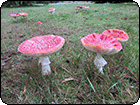Boys and girls, I would like to share the awesome English lesson about Halloween, death and dying I just did a few hours ago for a class of seven Latvian adults.
→[More:]
Most of the stuff about Halloween out there for teachers of English to non-native speakers assumes two things: 1) that your students are kids or teens, and 2) that your students would prefer to do something related to the culture of the holiday as it is celebrated in America or Britain. Neither of those two things applied here, so I ran with a much more general idea about death and dying.
I started by giving out
this photo of a Dia de los Muertos altar and having students work in small groups first name all the things in the photo, if they could (new words: skull, marigold, lace), and then guess what the significance of the altar was. We eventually got to an idea that it was to commemorate the people featured in the photo at the center-right, who had presumably died. I prompted students to describe what happens when someone dies, and they led me through different rituals for Orthodox and Lutheran/Catholic brands of Christianity as practiced here. This whole stage lasted about 40 minutes.
I then provided a handout on death (if you're a TEFL teacher, it's Unit 1 from
this book), which featured two articles about unusual funerals, a section on idiomatic expressions about death ("I would kill for a cigarette", "He bought the farm", "The traffic was murder", etc.), and an activity where students had to choose the correct forms of the verbs "die", "kill", and "murder" in set phrases, like "I'm __________ to meet her!" (answer: dying). The handout also had a question or two about legal procedures for disposing of remains in whatever country the students are from, so we discussed things like shooting one's ashes into space, or whether or not it's OK to bury Grandma in the backyard. This lasted about 30 minutes.
The final part of the lesson, which lasted about an hour, was reading the short Truman Capote story "A Lamp in the Window", from the collection
Music for Chameleons, but which I found divided into chunks, with questions for analysis after each section, in
Reading 3, (from Cambridge University Press, ISBN 9780521346733). I won't give away the ending, but it's a fun, short read, and ties in with the ideas we talked about earlier (I can't find the story itself online, but perhaps someone else can?).
A great discussion followed the end of the story: what it's like transitioning from life to death, how people we assume are "dead" are really alive, how we keep each other alive just by being human.
All in all, it was one of the best lessons I've done in my year-and-change of teaching English, and while it seems like all that would have required a lot of forethought and planning, so much of the energy came from the students that I just provided some "signposting" to students know what I expected them to do, and they ran with it. We could have expanded it in so many ways - looking at vocabulary, say, or exploring different tenses used to recount past events - but I'm really happy with what they
did get through, especially given the fact that they confronted an authentic text written for native speakers that they'd never seen before, which is a challenge for the best students of any language.
The final mark of success: no one left all the handouts on the table at the end of class, which can happen when students aren't interested enough to wait until the end of the lesson to pack their bags. Today they were enraptured with the story, with each other, and with the language until the very end. Yay!
And Happy Halloween!
 photo by splunge
photo by splunge
 photo by TheophileEscargot
photo by TheophileEscargot
 photo by Kronos_to_Earth
photo by Kronos_to_Earth
 photo by ethylene
photo by ethylene